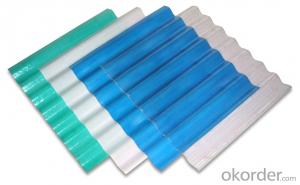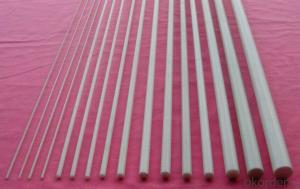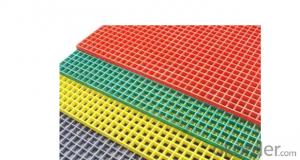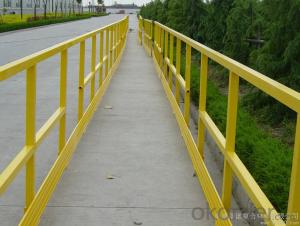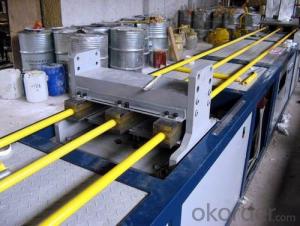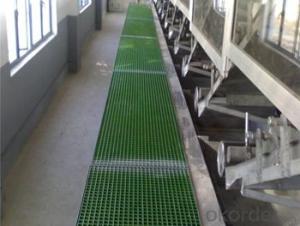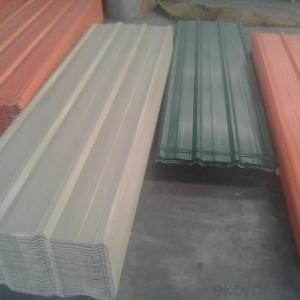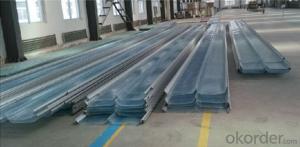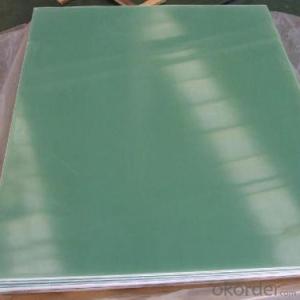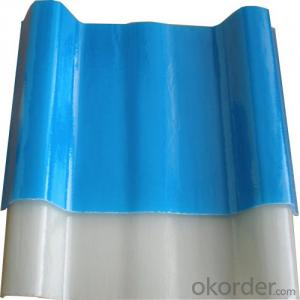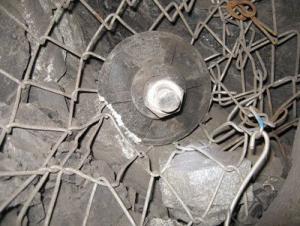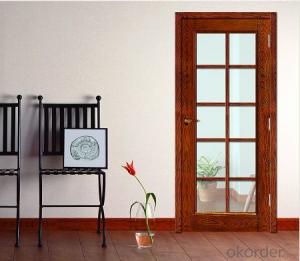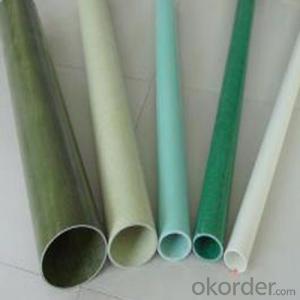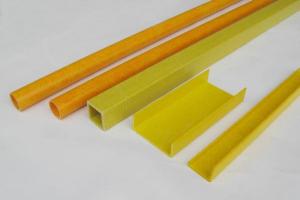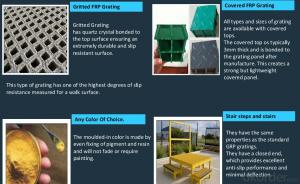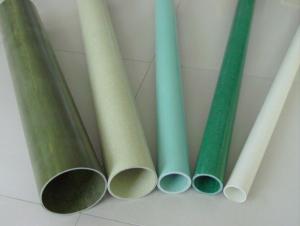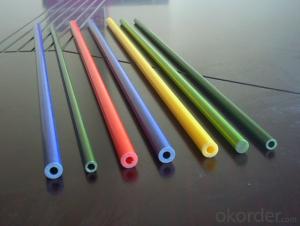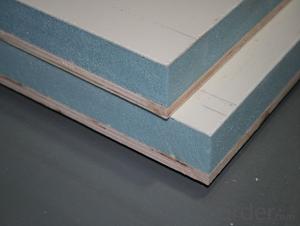FRP Pultrusion Profiles Fiber Reinforce Plastic Transparency Skylight Panel
- Loading Port:
- Qingdao
- Payment Terms:
- TT or LC
- Min Order Qty:
- 1000 m.t.
- Supply Capability:
- 10000 m.t./month
OKorder Service Pledge
OKorder Financial Service
You Might Also Like
Specifications
FRP Skylight Panel:
1,Energy-saving
2,Heat-resistant material
3,Insulated against noise
4,Good quality
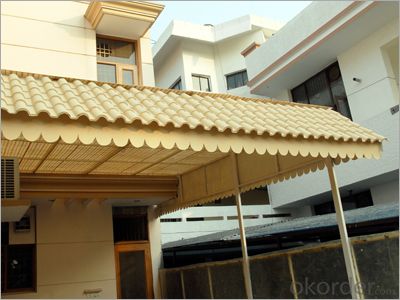
Features:
1) Owing to adopting continuous forming machinery, the length of theproducts is
not limited by product technique (except for transport equipment), any lengthand any section of panel can be made.
2) Excellent weather resistant property: surface is coated with ageingresistant film, which almost filters all UV light, the service life can be aslong as 20 years, greatly reduces the material cost and construction costbrought about by factors like the frequent change of PC boards
3) Good impact resistance and flexural strength make sure the translucentpanel can resist against the hit of hail and heavy typhoon
4) Excellent thermal stability: fiberglass panel belong to thermosettingfiber glass reinforced plastics, the thermal expansion coefficient is 2.2 x 10- 5cm/cmoc; PC (polycarbonate) are thermoplastics, the thermal expansion coefficientis 6.8 x 10 - 5cm/cmoc. When applied in big span buildings, the relativedisplacement of PC panel are too big, which results in the cracking andbreakage of hole position of screws, water leakage is virtually unavoidable
5) Fiberglass translucent panel are designed more personalized: FRP isheterogeneous material which can transform the direct light into diffusedlight, make the bright sunshine soft light friendly to man's eyes. The diffusedlight creates a comfortable working space (better effect in the region
6)General panels like PC, create direct light , which make the brightnessin the room uneven and cause man's eyes fatigued, overfocus makes floor orobjects change colors.
Heatnsulating property. The K (heat transfer coefficient) is small as2.0W/m2K. According to the test report issued by National Center forQuality Supervision & Test of Building Engineering (No.:BETC-QC1-2009-304R, refer to GB/T8484-2008), the result shows GRP of thicknessof 50mm, K is 2.0W/m2K.

Fire resistance: class B. According to the test repot issued by National Center for Quality Supervision & Test of Fire Equipment (No.: Zb200921913), refer to GB8624-2006, the result achieves class B.
Smooth surface, up to 85% in light transmittance. According to the test report issued by National Center for Quality Supervision & Test of Building Engineering (No.:BETC-QC1-2009-305G), refer to GB/T2680-1994, GRP of thickness of 50mm, the transmittance is up to 85%. In sunny days, the illumination indoors can reach to 1000 lux. Refer to DIN 5035, the illumination in public place just needs 500 lux, and 200 lux is enough in workshop. Though it is high in transmittance, light pollution is not existed.
Sound isolation: 28dB. According to the test report issued by National Center for Quality Supervision & Test of Building Engineering (No.:BETC-QC1-2009-304S), refer to GB/T50121-2005, GRP of thickness of 50mm, sound isolation is 28dB.
Wonderful mechanical performance, which is shown in high elasticity and impact resistance. According to the test report issued by National Center for Quality Supervision & Test of Building Engineering (No.:BETC-QC1-2009-305DA), refer to GB/T9962-1999, result shows the vertical flexural strength is 131MPa, the lateral one is 124MPa, and the bending strength is more than 80MPa.
Long service life: at least 30years. GRP enjoys good performance in light and UV light resistance, and passed long-time exposure experiment.
High safety- hard to broken. Those doors, windows, curtain walls, partition panels, etc. used commonly in public areas, industrial plants and warehouses presently can be replaced to avoid maintenance in winter.
Light in weight: GRP of thickness of 50mm, it is 6.8Kg/m2 in weight.
It is of no pollution, and has good performance in erosion resistance (oxidation, acid, alkali, salt, oil and grease resistance). If destructive fire happens, GRP will be burned to be water, co2, co and dust, exclusive of nitride, sulfide, halogen or heavy metal. The product of combustion is low in toxicity, even lower than the one of pine, the result of smoke toxicity test is class ZA3.

- Q: Can FRP pultrusion profiles be used in aerospace applications?
- Yes, FRP (Fiber Reinforced Polymer) pultrusion profiles can be used in aerospace applications. These profiles offer a combination of strength, lightweight, and corrosion resistance, making them suitable for various aerospace components such as structural supports, fairings, and interior panels. Additionally, FRP pultrusion profiles have high fatigue resistance and can withstand extreme temperatures, enhancing their suitability for aerospace use.
- Q: Can FRP pultrusion profiles be used in the renewable energy and solar power industry?
- Yes, FRP (Fiber Reinforced Polymer) pultrusion profiles can be effectively used in the renewable energy and solar power industry. FRP pultrusion profiles possess several key characteristics that make them ideal for such applications. Firstly, FRP pultrusion profiles have high strength-to-weight ratio, meaning they are lightweight yet strong, which is crucial in the renewable energy sector where materials need to withstand various environmental conditions while being cost-effective. Secondly, FRP pultrusion profiles offer excellent corrosion resistance, ensuring durability and longevity in outdoor and potentially corrosive environments, such as solar power plants or wind farms. Additionally, these profiles have excellent electrical insulation properties, making them suitable for electrical applications commonly found in the renewable energy industry. Moreover, FRP pultrusion profiles can be easily customized into various shapes and sizes, enabling the design and engineering of complex structures required for solar power installations or wind turbine blades. Furthermore, FRP materials are non-conductive and non-magnetic, making them safe for use in electrical and magnetic fields associated with renewable energy systems. Overall, FRP pultrusion profiles offer a combination of strength, durability, lightweight, corrosion resistance, and electrical insulation properties that make them highly suitable for use in the renewable energy and solar power industry.
- Q: How do FRP pultrusion profiles perform in extreme humidity conditions?
- FRP pultrusion profiles perform exceptionally well in extreme humidity conditions. The fiberglass-reinforced plastic material used in the profiles is highly resistant to moisture absorption, preventing any degradation or dimensional changes. This makes them ideal for applications in humid environments, as they maintain their strength, durability, and structural integrity over time.
- Q: Can FRP pultrusion profiles be used in agricultural applications?
- Indeed, FRP pultrusion profiles are applicable in the field of agriculture. Renowned for their remarkable strength-to-weight ratio, resistance to corrosion, and durability, FRP pultrusion profiles are an ideal choice for a variety of agricultural uses. One common utilization of FRP pultrusion profiles in agriculture is the construction of livestock enclosures, encompassing fences, gates, and pens. These profiles possess outstanding resistance to weather conditions, chemicals, and degradation caused by UV rays, ensuring their long-lasting performance in outdoor environments. Furthermore, their lightweight composition facilitates ease of handling and installation. Moreover, FRP pultrusion profiles find application in the production of agricultural equipment and machinery. They can be employed for structural components, such as beams and supports, as well as functional parts like handles, brackets, and covers. The impressive strength of FRP profiles enables them to withstand heavy loads and challenging operating conditions, while their resistance to corrosion guarantees their longevity in corrosive surroundings such as fertilizer storage areas or livestock waste management systems. Additionally, FRP pultrusion profiles can be utilized for irrigation systems in agriculture. Their non-conductive nature renders them perfect for situations requiring electrical insulation, such as the creation of irrigation pipes or channels. Furthermore, the corrosion resistance of FRP profiles ensures their ability to endure exposure to water, chemicals, and fertilizers frequently employed in agricultural irrigation. To summarize, FRP pultrusion profiles exhibit exceptional suitability for agricultural applications due to their high strength, resistance to corrosion, and durability. Whether employed in livestock enclosures, agricultural machinery, or irrigation systems, FRP profiles offer numerous advantages that position them as a reliable choice within the agricultural industry.
- Q: Are FRP pultrusion profiles resistant to moisture absorption?
- Yes, FRP pultrusion profiles are highly resistant to moisture absorption. The inherent properties of the fiberglass and resin used in pultrusion manufacturing make the profiles highly durable and impervious to moisture, ensuring long-term performance and minimal structural damage.
- Q: Can FRP pultrusion profiles be used in renewable energy projects?
- Yes, FRP pultrusion profiles can be used in renewable energy projects. FRP (Fiber Reinforced Polymer) pultrusion profiles offer high strength, durability, and corrosion resistance, making them suitable for various applications in renewable energy projects. They can be used in the construction of wind turbine blades, solar panel frames, and structural supports for renewable energy infrastructure. Additionally, FRP pultrusion profiles can provide cost-effective solutions by reducing maintenance requirements and improving the overall performance of renewable energy systems.
- Q: Can FRP pultrusion profiles be used in the construction of outdoor signage?
- Yes, FRP (Fiber Reinforced Polymer) pultrusion profiles can be used in the construction of outdoor signage. FRP pultrusion profiles are known for their durability, strength, and resistance to various environmental conditions, making them suitable for outdoor applications. These profiles are typically made of a combination of fiberglass reinforcement and resin matrix, resulting in a lightweight yet strong material. Outdoor signage often needs to withstand harsh weather conditions, such as rain, sun exposure, and temperature fluctuations. FRP pultrusion profiles have excellent resistance to corrosion, UV rays, and moisture, ensuring that the signage can maintain its structural integrity and visual appeal over time. Furthermore, FRP pultrusion profiles can be customized to meet specific design requirements, allowing for flexibility in creating unique and eye-catching outdoor signage. These profiles can be easily shaped, cut, and assembled, making them a versatile choice for signage applications. In summary, FRP pultrusion profiles can indeed be used in the construction of outdoor signage due to their durability, resistance to environmental conditions, and flexibility in design.
- Q: Are FRP pultrusion profiles resistant to chemicals used in chemical plants?
- FRP pultrusion profiles exhibit a general resistance to a wide range of chemicals employed in chemical plants. Their exceptional chemical resistance properties make FRP materials appropriate for diverse industrial applications, including chemical plants. The pultruded FRP profiles are manufactured by saturating reinforcing fibers with a thermosetting resin, such as polyester, vinylester, or epoxy. The selection of these resins is based on their resistance to various chemicals and can be tailored to meet specific requirements. FRP pultrusion profiles have demonstrated their ability to withstand aggressive chemicals, including acids, bases, solvents, and corrosive gases. Most common chemicals found in chemical plants, such as sulfuric acid, hydrochloric acid, nitric acid, and sodium hydroxide, typically do not affect them. Nevertheless, it is important to consider that the resistance of FRP pultrusion profiles may vary depending on the specific resin system, as well as the concentration and temperature of the chemicals involved. To ensure the suitability of the chosen FRP profiles for the chemical environment in a chemical plant, it is always advisable to consult with the manufacturer or supplier.
- Q: Are FRP pultrusion profiles non-conductive?
- Yes, FRP (Fiber Reinforced Polymer) pultrusion profiles are non-conductive. This is because they are made up of a combination of reinforced fibers, typically fiberglass, and a polymer resin matrix. The fiberglass fibers provide the strength and stiffness, while the polymer resin acts as a binder to hold the fibers together. One of the key advantages of FRP pultrusion profiles is their excellent electrical insulation properties. Unlike metals, which are conductive, FRP profiles do not conduct electricity. This makes them ideal for applications where electrical insulation is required. In addition to being non-conductive, FRP pultrusion profiles also offer other benefits such as corrosion resistance, high strength-to-weight ratio, and low maintenance requirements. These properties make them suitable for a wide range of applications, including electrical and telecom infrastructure, chemical processing plants, bridges, and building construction. It is important to note that the non-conductive nature of FRP pultrusion profiles does not mean they cannot be made conductive if required. Special additives or coatings can be incorporated during the manufacturing process to impart conductive properties if needed.
- Q: Can FRP pultrusion profiles be used in the construction of solar panel frames?
- FRP pultrusion profiles are a viable option for constructing solar panel frames. These profiles possess qualities such as being lightweight, strong, and corrosion-resistant, making them an ideal material choice. Their durability and high strength-to-weight ratio ensure that the frames can withstand different weather conditions and prolonged exposure to sunlight. Moreover, FRP pultrusion profiles can be easily customized to meet specific design requirements, providing flexibility in solar panel frame construction. All in all, utilizing FRP pultrusion profiles in this industry offers multiple benefits, making it a suitable choice for the solar energy sector.
Send your message to us
FRP Pultrusion Profiles Fiber Reinforce Plastic Transparency Skylight Panel
- Loading Port:
- Qingdao
- Payment Terms:
- TT or LC
- Min Order Qty:
- 1000 m.t.
- Supply Capability:
- 10000 m.t./month
OKorder Service Pledge
OKorder Financial Service
Similar products
Hot products
Hot Searches
Related keywords
